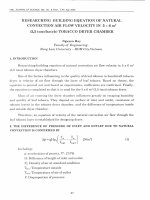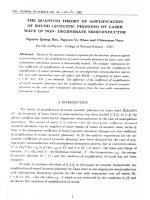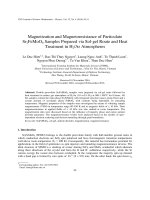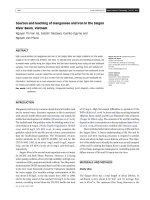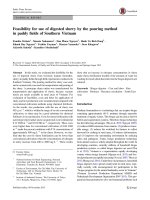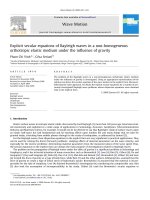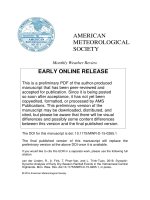DSpace at VNU: Leadership in Times of Recession: An Empirical Research of Private Enterprise Leadership in Vietnam
Bạn đang xem bản rút gọn của tài liệu. Xem và tải ngay bản đầy đủ của tài liệu tại đây (278.9 KB, 12 trang )
VNU Journal of Economics and Business Vol. 29, No. 2 (2013) 75-86
Leadership in Times of Recession: An Empirical Research of
Private Enterprise Leadership in Vietnam
Phùng Xuân Nhạ*, Lê Quân
Vietnam National University, Hanoi,
144 Xuân Thủy Str., Cầu Giấy Dist., Hanoi, Vietnam
Received 15 March 2013
Revised 15 May 2013; Accepted 30 May 2013
Abstract. In 2012 Vietnam recorded that around 55.000 enterprises went bankrupt. Currently,
only 312.600 enterprises are still in operation out of the 694.000 enterprises established since the
enactment of Vietnam’s Law on Enterprises in 1999. This paper presents the results of an
empirical study of business leaders through business decisions they made during 2008-2012 to
ensure their companies’ survival; their forecast and expectations for when the recession is over and
the competencies needed for successful leadership in times of recession. The survey sample was
composed of 478 CEO and 561 senior managers in Vietnamese private enterprises. The paper
concludes by suggesting top priorities for 2013 and also a set of leadership competencies needed
for business leaders in times of recession. The survey results show that business leaders are less
optimistic than they have been in the last year about the economic situation and are still weak in
economic forecasts, financial management and risk management. During and after the recession,
opinions and perceptions of business leaders have actively changed towards sustainable value and
leadership. Leadership in the new context requires greater flexibility, and better adaptation to the
business environment, which is increasingly complex and difficult to predict.
Keywords: Leader, leadership, Vietnam, private enterprises.
1. Background∗
until four years later, when the Law on Private
Enterprises and the Companies Law were
enacted that we have witnessed the birth and
growth of private enterprises, especially in the
South of Vietnam. In the later stage of Doi moi,
large private enterprises were often active in the
field of consumer goods production to meet the
huge demand from the local market at the time.
Meantime, some of the first foreign banks
(ANZ, BNP) came to Vietnam in 1990 and the
private sector began to take off. In just 5 years
from 1993 to 1997, there were nearly 20
It is said that the explosion of private
enterprises in Vietnam in the last decade has
been associated with institutional reforms for
the private sector and with the opportunity to
access inexpensive capital.
The concept of the private sector began to
be recognized in 1986. However, it was not
_______
∗
Corresponding author. Tel.: 84-4 37547670
E-mail:
75
76
P.X. Nhạ, L. Quân / VNU Journal of Economics and Business Vol. 29, No. 2 (2013) 75-86
thousand
private
enterprises
newly
established(1). It can be said that at this stage,
the first generation of entrepreneurs and
business leaders of Vietnam was developed.
However, opportunities always come with
challenges. The battle to compete with foreign
competitors has forced numerous businesses to
go bankrupt or to sell their businesses.
collapse has still had no sign of stopping.
Consequently, in the last 5 years, the GDP
growth of Vietnam has twice reached the
bottom according to the theory of consecutive
recession in a W-shaped graph (the first time in
2009 when GDP growth reached 5.3% and the
second time in 2012, when GDP growth was
only 5.03%)(3).
The normalization in relations with the
United States and in the joining of ASEAN in
1995 Vietnam showed that it had entered the
international integration. The fact that the Law
on Enterprises was amended in 1999, then
revised again in 2005 stimulated young people
to have the ambition to take part in and to lead.
From then, the strength of the economy was
raised and officially booming when the stock
market and several commercial banks were
born and foreign capital flowed torrentially into
Vietnam from investment funds. During 20002008, the number of newly established nonstate enterprises increased by 15-fold at an
average rate of 22% a year(2). The term private
enterprises, joint stock companies, limited
liability companies have been very popular.
Image and brands of business are associated
with the image and reputation of the founder.
The founder of the business is the leader.
Several new businesses have just been
established, but are growing rapidly. Their
common similarity was that they were usually
managed by members of a family (which was
considered effective and safe?) and actively
participated in the stock market and real estate
market (highly profitable?).
Looking back at the 25 years of
establishment and development of private
enterprises in Vietnam (1987-2012), we see two
basic elements that created success. These were
the change in the macro economy and
investment from capital markets. However,
when the economy fell into recession with
tighter lending conditions and declining
purchasing power, private enterprises have gone
bankrupt or suspended operation. In this
scenario, a series of seminars have been held to
seek solutions for business difficulties and
those seminars often talk about the role of
business
leaders.
Meanwhile,
scholars,
researchers and even business leaders agree that
the key to success or failure in the past has been
leadership capability. Therefore, to help
businesses out of a crisis, leadership is
considered as one of the most important factors.
Financial and real estate bubbles breaking
(starting in 2008) led to the collapse of a series
of businesses. Up until now, after 5 years, the
_______
(1)
GSO, 2010.
/>
2. Once the recession ends and a recovery
begins
During 2008-2009, people experienced one
of the severest recessions in the world since the
1930s. This recession touched the global
economy and, unlike the previous recessions,
the financial sector was identified as the main
source of the crisis (Athey, 2009).
Question: How did small and medium
enterprises (SMEs) respond to this recession?
_______
(3)
GSO, 2012.
P.X. Nhạ, L. Quân / VNU Journal of Economics and Business Vol. 29, No. 2 (2013) 75-85
According to many authors, SMEs have less
control over their external environment when
compared with larger firms (Smallbone, D.,
North, D. and Kalantaridis, C., 1999) and SMEs
perceive recessions as “an externally controlled
condition over which they have no control”. To
be able to overcome a crisis, SMEs must have a
strategy. A literature review shows that SMEs’
strategies could be divided in two main groups:
One strategy is cost-cutting to survive the
recession and focus on growth to retain capacity
when the recession is over. A cost-cutting
approach is evident in the construction and
manufacturing sectors and includes downsizing
the workforce, reducing products, reducing
stock, and freezing pay. The other strategy is a
growth approach which means offering new or
improved products, competing on price, and
acquiring other firms that have been weakened
by the recession (Stone, 1975). Regarding the
growth strategy, a study of SMEs’ responses to
the 2008-2009 recession showed that product
diversification, including the introduction of new
goods/services and attraction of new customers,
was one of the most effective way to help SMEs
respond to recession (Kitching, J., Smallbone, D.
Xheneti, M., Kasperova, E., 2011).
77
The economist Drucker always sees crisis
as providing great opportunities. According to
him, doing nothing (or not enough) in a time of
crisis may sink companies. Indeed, he states
that there are no risks, only opportunities
(Drucker, 1973) and in order to transform the
risk into an opportunity the first step is to
decide what to divest, meaning to make a clear
decision on what to withdraw and on what to
concentrate.
One of the most important things to help to
seize opportunity from crisis is confidence in
economic conditions and expectations about the
future. These are considered as two key drivers
for SMEs to continue to invest in and grow
their business (Chow, M.J., and Dunkelberg,
W.C). Our research shows that during a
recession, business owners are considerably
more optimistic than employees (Storey, 2011)
and there is always the potential for
entrepreneurial spirits to pursue opportunities
counter-cyclically by creating their own
confidence and bootstrapping resources (Rae,
D., Price, L., Bosworth, G. and Parkinson, P,
2012).
4. Developing leaders in times of recession
3. Seizing opportunity from crisis
Economic history teaches that after every
recession there is a recovery and there is always
opportunity in crisis. The word “crisis” in
Chinese is composed of two characters. One
represents danger and the other represents
opportunity(4).
Question: How to seize opportunity from
crisis?
_______
(4)
John F. Kennedy quote.
Leadership is different to management.
Management is often known as a maintenance
activity,
concerned
with
technical
implementation of policies and procedures
while leadership often links with shaping
others’ goals, broader values and sense of
purpose, especially in relation to change and
mobilizing staff effort by engaging, inspiring
and
supporting
individual
and
team
performance (Cuban, 1988). Leadership can be
conceptualized as a collective phenomenon
where different individuals contribute to the
78
P.X. Nhạ, L. Quân / VNU Journal of Economics and Business Vol. 29, No. 2 (2013) 75-86
organization (Pettigrew, A., and Whipp, R,
1991). Leadership competencies refer to the
knowledge, skills, or abilities that facilitate
one’s ability to perform a task (Boyatzis, 1982).
In a crisis situation, leadership is collective
and dynamic, and it requires perception and
sense-making skills by leaders in order for them
to determine appropriate courses of action
(Weick, 1988). During crisis, leaders should
focus on decision making, communication,
creating organizational capabilities, sustaining
an effective organizational culture, managing
multiple constituencies, and developing human
capital (Bolman, 1997). Therefore, the
leadership competencies they need are related
to managing the operational, strategic, and
human resource functions, and also financial
functions (Denis, J., Lamothe, L., and Langley,
A. (2001).
Effective leaders are leaders who manage to
encourage staff to actively engage in knowledge
acquisition and the formulation of strategies to
resolve the crisis (Dutton, J. E., and Jackson, S.
E., 1987). However, in most cases leaders are
not prepared to manage the crisis (Garcia,
2006). As business environments change and
grow increasingly complex, it is important that
leaders develop a set of skills that will help
them prevent and effectively respond to crisis
(Burnett, 2002).
5. Data collection and analysis
This empirical research was part of a
continuing research project under Vietnam HR
Day. Vietnam HR Day is the largest open
forum to discuss human resource issues in
Vietnam and is also the annual human resource
forum for business leaders and human resource
specialists in Vietnam. Vietnam HR Day 2012
had the topic “Quality of Vietnam Business
Leaders” with the goals of evaluating the
quality of Vietnamese business leaders against
the demand for development and international
integration, including their responses to
recession, forecast and expectations when
recession is over and competencies are needed
for successful leadership.
To evaluate the quality of business leaders
(including CEOs and Deputy CEOs) in
Vietnamese private companies (total private
ownership should be at least 51%), we divided
the population into two treatment groups (a
group of business leaders and a group of senior
managers) and conducted two questionnaire
surveys separately.
In the first survey, the objective was to
capture not only business decisions that the
business leaders made during 2009-2012 to
make their companies survival (especially
during 2011- 2012 when the full-blown crisis)
but also their forecast and expectations when
the recession was over and the competencies
needed for successful leadership in times of
crisis.
In the second survey, senior managers were
asked to evaluate their leaders’ quality
(strengths and weaknesses in competency).
Survey steps: (1) E-mail invitations were
sent containing a link to the internet-based
questionnaire (www.vinatest.vn). These e
invitations were sent separately to the members
of Vietnamese Young Leaders Association
(more than 1000 CEO of SMEs) and of HR
Link (more than 10.000 HR Managers). The
survey started in July 2nd 2012 and closed on
August 31st 2012; (2) Valid answers were
checked and selected (478 valid answers from
business leaders and 561 valid answers from
senior managers in total); and (3) The data was
coded and analyzed in SPSS.
P.X. Nhạ, L. Quân / VNU Journal of Economics and Business Vol. 29, No. 2 (2013) 75-85
6. Results and findings
In this paper, we present the findings and
analysis of the two surveys: self-evaluation by
business leaders and assessment by senior
managers. The survey results include a profile
of business leaders (age, gender, education, and
seniority), forecasts for Vietnam’s economic
recovery, top priorities in times of recession,
leadership and management performance, and
leadership competencies needed. The SMEs
studied were diverse in terms of business area,
legal form, turnover and number of employees.
Profile of business leaders
According to the survey results, women
leaders only accounted for 24.5% in 2012 of
surveyed leaders. Leaders had a fairly high
level of education. 58.5% of the leaders were at
the university or college level. Notably, over
35% of the leaders had postgraduate training.
This result was very encouraging compared to
previously published surveys of education
leaders of non-state enterprises (Le Quan,
79
2011). However, it is also noted that this survey
sample was mostly from big cities and would
not be nationally representative.
Regarding ages, leaders surveyed have an
average age of 38.6 years. The oldest was 60
years old and the youngest 19 years old. Thus,
the average age of the leaders of non-state
enterprises is relatively young. Over 70% of
business leaders participated as business
operators before the age of 35.
Regarding general management experience
(managerial participation), 34% of the leaders
had under 5 years experience in management.
The number of leaders having management
experience from 5 to 10 years was 42.8% and
22.6% for those with 10 years experience.
Similarly, leadership experience of leaders
participating in operational executives was
commonly from 3 to 5 years (44.7%) and 5
years (29.6%). Up to 24.5% of new business
leaders were involved in executive committees
for at least three years time.
Vietnam economic recovery forecast
Figure 1: Forecast for Vietnamese economy recovery (n=478).
80
P.X. Nhạ, L. Quân / VNU Journal of Economics and Business Vol. 29, No. 2 (2013) 75-86
In recognition of the economic cycle and
the estimated time of recovery of the
Vietnamese economy, 84% of the surveyed
leaders said that recovery would take 24
months. The number of leaders that believed in
economic recovery in the next 12 months was
7%. The number of leaders who were in favor
of Vietnam economics recovery by the end of
2012 and the first half of 2013 accounted for
only 4%. These survey results are very different
from the results in the survey from Vietnam HR
Day in 2011. Before that, most business leaders
felt that the economy would recover after 6 to
12 months. The practice shows that the
perceptions of business leaders in Vietnam,
when planning business in 2012, is cautiously
optimistic, and that business leaders are surely
adjusting their action as the recognition is less
optimistic at the moment. The trend towards
safer recognition and the forecast form of
business leaders in Vietnam is increasing.
environment outside are more and more
unpredictable and unstable. Most of the leaders
highly agreed that the biggest challenge for
current decision-making is that the business
environment
is
becoming
increasingly
complicated (4.119) and risky due to policy
changes (3.917).
Leadership and management performance
Compared to the our survey results of 2011,
most indexes are at a moderate or below
average level. Specifically, the index of
business performance; and leadership and
management performance is just under 3.25 on
the average.
The administrative work that is evaluated at the
highest level includes marginal cost management,
production management and quality control (at
level of 3.3-3.45). Risk management activities are
evaluated lowly (2.97). Strategic management and
human resource management also received low
satisfaction levels. It can be said that business
leaders are unhappy about the administration work
on both overall dimensions and specific functions.
Besides, the decision-making process of
business leaders seems to become increasingly
difficult when the elements from the business
Table 1: Leadership and management performance (n=478)
Business performances
Leadership and management performance
Human resource management
Financial management
Strategic management
Risk management
Marketing
Customer relationship management
Partner development and management
Production management
Quality management
Increasing operational efficiency in IT
Cost saving
Productivity
Valid N (listwise)
N
471
462
459
459
459
456
453
450
447
438
444
447
459
444
408
Min
1.00
2.00
1.00
1.00
1.00
1.00
1.00
1.00
1.00
2.00
1.00
1.00
1.00
1.00
Max
5.00
5.00
5.00
5.00
5.00
5.00
5.00
5.00
5.00
5.00
5.00
5.00
5.00
5.00
Average
3.1274
3.2403
3.1111
3.1699
3.1176
2.9737
3.0530
3.2467
3.2886
3.3356
3.3446
3.2550
3.3791
3.2432
Deviation
.63641
.63576
.76400
.72200
.77579
.88166
.77962
.73962
.77195
.71541
.68568
.71644
.71484
.65443
P.X. Nhạ, L. Quân / VNU Journal of Economics and Business Vol. 29, No. 2 (2013) 75-85
81
t
The challenge of recession
The process of leadership that seemed to be
facing a major challenge was the innovation of
chain value. As recognized by the leaders, a
short-termed business trend is no longer a wise
choice (only 2.89 in average). Along with that
gross margin tended to decrease, low manpower
cost was not feasible, and business
opportunities were increasingly less. Business
labor productivity in 2011 and 2012 was in the
decreasing direction and has not yet seen much
improvement in opportunities.
Table 2: Challenges of recession (n=478)
Business environment becomes more complex
Risks of Government policy changes
Necessity of business restructuring
Predicting market trends will be more challenging
Need to restructure the market towards internationalization
Pressure from rising labor costs
Decline in margins due to increasing input cost
Tendency to a decrease in gross margin
Business opportunities were increasingly less
Shorter product life cycle
Tendency for Public-Private Partnership
Bankruptcy or suspension of operation
Business opportunities were increasingly less
Existing products meet market demand no longer
Short-termed business trend
N
477
474
477
474
474
477
477
477
474
474
477
474
471
474
474
Min
1
1
1
1
1
1
1
1
1
1
1
1
1
1
1
Max
5
5
5
5
5
5
5
5
5
5
5
5
5
5
5
Average
4.119497
3.917722
3.899371
3.810127
3.740506
3.698113
3.679245
3.616352
3.556962
3.455696
3.45283
3.373418
3.133758
3.082278
2.892405
ku
This suggested that 2012 was a pivotal year
for innovation for numerous companies in
Vietnam. In the scenario of economic crisis,
businesses need to reconsider the chain value
and the competitive advantage to breakthrough
in business. This perspective got high sympathy
among various business leaders as the average
value of the variable “need to restructure the
market towards internationalization” reached
3.74; and the “necessity of business
restructuring” was at the level of 3.899.
Top 4 things that should be done in the
times of recession
gj
Leaders’ prioritized decisions seemed to be
selected according to 3 levels: instantaneous
priority for decisions having an immediate
effect, then, decisions affecting the medium and
long term.
To overcome difficulties in the current period,
business leaders indicate that the decisions of top
priority are restructuring and optimizing the financial
system; cutting down operating costs; eliminating
ineffective operational business activities; and
reforming the reward system. These are a group of
solutions which would directly affect the outcome
and efficiency of business in the short term.
82
P.X. Nhạ, L. Quân / VNU Journal of Economics and Business Vol. 29, No. 2 (2013) 75-86
Figure 2: Top priorities in the times of recession (n = 478).
Leadership competencies needed
Le Quan (2010) highly emphasized
creativity, learning, justice, and influence
(leadership skills). But the results of the survey
in the scenario of the economic crisis in 2012
showed that the three most important qualities
of business leaders were focus on sustainable
development, working enthusiasm, and
willingness to take risks. It seemed that these
three qualities were appropriate for leaders to
pass a crisis. When the focus for sustainability
is ranked first by leaders, it would be a good
sign for the economy in Vietnam in future
years.
Uo
Figure 3: Leadership competencies needed (n = 478).
In this survey, courage and risk-taking were
viewed differently. Identifying and accepting
risks are different from bravery and sacrifice.
Besides, qualities such as vision, global
thinking and clearly understanding the industry
were often in the selection of several leaders.
Realistic vision and pragmatism was probably
never featured as highly appreciated.
Because the survey was limited leaders had
three qualities to choose from and leaders
83
P.X. Nhạ, L. Quân / VNU Journal of Economics and Business Vol. 29, No. 2 (2013) 75-85
would consider only the most important to
select. The rise of the quality of vision was
pushed up, meaning the other important
qualities would be relegated. Ambition, fairness
and modesty thus ranked last in the selection of
business leaders in 2012.
Leaders’ competencies assessed by senior
managers
In the second survey, senior managers were
asked to assess their leaders’ competencies. The
survey results showed that no leadership
competency is assessed as good or excellent by
senior managers. All average values are less
than 4.0. Based on the results of SPSS data
processing, we have 8 groups of leadership
competencies according to the evaluation of
senior managers as follows (in order of highest
overall rating to lowest):
Group 1: Competencies that are rated the
highest belonged to the essential qualities of
leadership. These qualities have the highest
average value, above 3.9 with a small standard
deviation:
1. Devoted to work
2. Optimistic about the future
3. Having a good and detailed memory
4. Assertiveness
5. Able to build good relationships
Group 2: Competencies that are evaluated
fairly include:
6. Persuasive communication skills
7. Management by deadline
8. Fierce job deployment
9. Quickly identify and solve arising
problems of business.
10. React quickly to changes in the
environment
Group
3:
Personnel
management
competencies rated passable include:
11. Always encourage employees to learn
12. Always encourage employees to commit
to work
13. Always make employees confident in
the future of the business
14. Always
achievement
direct
staff
to
higher
15. Capture ideas quickly and staff are
encouraged to give ideas
Group 4: Other managerial competencies
rated passable include:
16. Practical thinking
17. Thinking openly to receive new ideas
and initiatives
18. Recognizing good opportunities and
challenges coming from the business
environment
19. Establishing relationships inside and
outside the enterprise to implement strategies
20. Deep understanding of functions and
stages of business expertise
21. Thinking deeply and not rigid in
decisions
22. Always prioritizes tasks to deal with
23. Always focus more on efficiency and
results than on superficialities
Group 5: Competencies that are rated at an
average level (average value from 3.3-3.5)
include:
24. Exemplary (leads by example)
25. Does not mind little details and be mean
at work
26. Always has personal responsibility
27. Plays spokesperson role at the right
time, right place
28.
Listening
communication
skill
and
two-way
84
P.X. Nhạ, L. Quân / VNU Journal of Economics and Business Vol. 29, No. 2 (2013) 75-86
29. Always establishes behavioral attitude
norms at work
30. Always explains why businesses must
change
31. Encourages staff to recognize and
correct errors
32. Establishes a vision for clear business
Group 6: Competencies that are rated
unsatisfactory, in which there are many human
resource capacities:
33. Fair treatment for employees
34. Focuses on salary and bonus
35. Always interested in sharing and
orientating and supporting staff to develop
themselves
36. Communicates clearly work to the
individual and group
37. Often offers staff difficult tasks for
developmental opportunities
38.
Always
harmonizes
between
employees’ benefits and the group’s benefits
39. Recognizes and appreciates correctly
success and failure of staff
46. Always focuses on developing multitalented staff who are knowledgeable about
several areas of expertise
47. There are clear strategies and plans, and
always communicates to employees to
understand and share
48. Creates
framework
a
good,
qualified
staff
49. Always clarifies the position of
employees in enterprises in the short and long
term
50. Always defines for the employees the
link between the short-term goals and long-term
goals of the company
51. Always interested in sharing with staff
about the strengths and weaknesses and
solutions to overcome them
Group 8: Competencies that are evaluated
very weak include:
52. Evaluating employee
scientifically and fairly
performance
53. There are numerous human succession
plans
40. Always attempts to make employees happy
54. Allows plenty of time for sharing and
training for staff
41. Always orients employees to outreach
new competency standards from the context of
integration
55. Behaves less emotionally and adjusts
quickly when making mistakes
Group 7: Competencies are rated weak by
senior managers, including:
42. Interested in balancing life and work of
employees
43. Good decentralization, focus on work
authorization
44. Feedback to employees about their work
and themselves
45. Always clarifies the rights
responsibilities of each staff member
and
As a result, business leaders were reviewed
highly on their business positions. Their
leadership and human resources management
competencies were not appreciated by senior
managers. Even in the area of human resource
competency, skills that were appreciated better
were often about encouraging subordinates to
try and learn, rather than about rewarding good
capabilities, training and coaching subordinates.
Business leaders spent little time for
subordinates and behaved emotionally and did
not establish a performance evaluation system
P.X. Nhạ, L. Quân / VNU Journal of Economics and Business Vol. 29, No. 2 (2013) 75-85
for staff scientifically and fairly. In addition,
business leaders were estimated lowly in
successor's development.
7. Conclusion
The economic crisis is incredibly
meaningful to business leaders. Through the
crisis, business leaders revealed several
weaknesses that they have not recognized
before and it has also provided an opportunity
for business leaders to reconsider and evaluate
corporate administration. The survey showed
that earlier business leaders were considerably
optimistic and paid little attention to
macroeconomic forecast. When the economic
difficulties appeared constantly with growing
and prolonged influence, that optimism was
associated with subjectivity which led to
incorrect decisions such as scattering
investment strategy, lack of focus on financial
management and human resource management,
and diversifying too quickly. Year 2012 marked
a shift towards a more sustainable value of the
business leaders in Vietnam.
Risk in policy changes and the environment
had great pressure on the decisions of business
leaders. Consequently, various business leaders
turned from the extreme of exceeding optimism
in investment to the extreme of caution and
worry when making decisions.
Most business leaders’ extation of a recovery
in the next 24 months would lead to cautious
decision and restrictions in investment. Prior
business objectives shifted from increasing
growth to higher quality and safety. According to
economic theory, this would lead to investment
flows of foreign enterprises to reduce in the future
if the government did not quickly have measures
to improve the situation and develop confidence
in the business environment.
Business leaders in private enterprises are
highly evaluated on quality and thinking.
However, there are numerous skills that are
85
weak, especially people management skills such
as training, subordinate guidance, and
developing high-quality human resources. As
the systematic operation is not good,
corporation hierarchy cannot be developed. The
obvious consequence is that the firm will have a
difficulty in attracting talent.
8. Recommendations
Corporate management and governance
should be based on a “cool head” rather than a
“hot head”. The disadvantages of today's
business, besides the objective reasons, mostly
came from the results of downplayed strategic
management, risk management and operational
management (financial, human, marketing,
production...). The survey results in 2011
indicated that businesses were growing hot on
the low quality of human resources. To be able
to innovate a value chain strategy and move
towards sustainable competitive advantages and
improve value, corporate investment should be
prepared for many years.
The fact is that successful business in the
modern world is only dependent a little on
clients from the public sector. Therefore
businesses need to focus on developing
products and services towards the private
sector. This helps the development to be more
sustainable and less risky due to pressure from
public spending cuts.
The economic crisis is a challenge; but on
the other hand, it is an opportunity. Enterprises
should define long-term advantages on the basis
of spending time and effort to prepare the next
steps for the next 3 years within the crisis. The
economic cycle is increasingly short in span 2-3 years. Therefore, positive managerial
thinking is actively exploiting the economic
crisis as a treatment phase, preparing the
86
P.X. Nhạ, L. Quân / VNU Journal of Economics and Business Vol. 29, No. 2 (2013) 75-86
foundation for the next stage. Managing a team
of key personnel, building a culture of creativity
and innovation, and decentralizing greatly to
build a compact system, are all necessary.
Differentiated and focused strategy has
been confirmed. During the growing phase,
profit might be sought from various places and
sources. However, if the investment spreads
widely, the economic crisis will immediately
cause the death of the business. Therefore,
business leaders need to identify clearly
strategies and consistency.
Investing in people always brings a lasting
effect. Therefore, business leaders should focus
on training for themselves and embrace learning
actively. Only when business leaders organize
their work well, have good leadership and good
management systems, business will attract, use,
and develop capable people. A business leader
with poor competencies will find it difficult to
attract and use talent.
References
[1] Athey, G., Economic Development in the UK:
Challenges During and After the Recession. Local
Economy, 2009, 604-611.
[2] Smallbone, D., North, D. and Kalantaridis, C.
(1999). Adapting to peripherality: a study of
small rural manufacturing firms in northern
[3]
[4]
[5]
[6]
[7]
[8]
[9]
[10]
[11]
[12]
[13]
England.
Entrepreneurship
and
Regional
Development, 1999, 109-127.
Stone, J., Small Business Management in a
Recession.
Journal
of
Small
Business
Management, 1975.
Kitching, J., Smallbone, D. Xheneti, M.,
Kasperova, E., Adapting to a Fragile Recovery:
SME Responses to Recession and Post-Recession
Performance.
Small
Business
and
Entrepreneurship Conference. Sheffield, 2011.
Chow, M. J., and Dunkelberg, W. C., The Small
Business Sector in Recent Recoveries. Business
Economics, 2011.
Storey, D. J., Optimism and chance: The elephants in
the entrepreneurship room. International Small
Business Journal, 2011, 303-320.
Rae, D., Price, L., Bosworth, G. and Parkinson,
P., “Business Inspiration: Small business.
Industry & Higher Education, 2012, 473-489.
Le Quan, Sales management, Statistical
Publishing House, 2010.
Le Quan, Using ASK Model to evaluate quality of
business leaders in Vietnam. Journal of Business
and Economics, UEB-VNU, 2011.
Anderson, A. and Russell, E., Small Businesses In
Economic Adversity; Impact, Affect And
Responses. Paper presented at Institute for Small
Business and Entrepreneurship Conference, 2009.
Phung Xuan Nha, Leadership and business culture
in Vietnam facing global integration. VNU
Publishing House, 2011.
Phung Xuan Nha, Le Quan, Application of
leadership competency in leader dvelopement in
public sector. Communist Review, 2012.
IMB, CEO Report, 2010.

